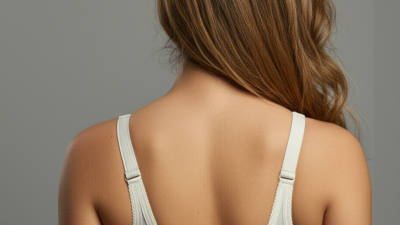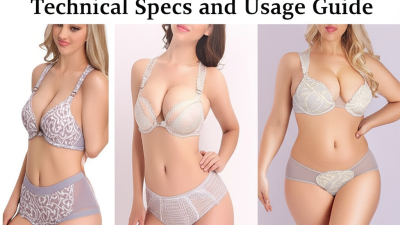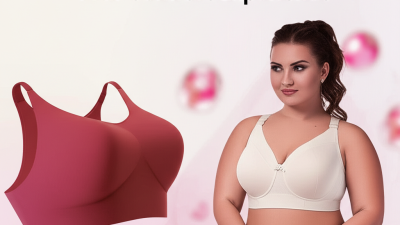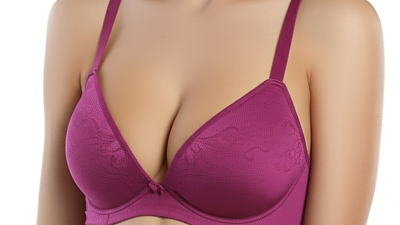The Rise of Back Bras: Understanding Their Impact on Comfort and Posture for Women Today
The introduction of back bras in the lingerie market represents a significant evolution in women's undergarments, combining comfort and functionality with style. Recent studies indicate that nearly 70% of women report experiencing discomfort from traditional bras, often leading to poor posture and health issues. The back bra, designed with innovative features such as cross-back straps and wider bands, promises to alleviate these concerns by distributing weight more evenly and providing essential support. Furthermore, a report by the Intimate Apparel Council highlights that the demand for comfort-driven apparel has surged by 40% in the past five years, signaling a trend towards bras that prioritize wearability without sacrificing aesthetics. As such, understanding the impact of back bras on both comfort and posture is crucial for women seeking a modern solution to their lingerie needs.
The Historical Context of Women's Bras and the Emergence of Back Bras
The history of women's bras is a fascinating journey that reflects broader societal changes and the evolution of women's roles. The early iterations of bras can be traced back to the 19th century when corsets dominated women's undergarments. These corsets, designed to sculpt the body and emphasize an hourglass figure, often came with significant discomfort, restricting movement and adversely affecting women’s posture. The shift towards comfort began in the early 20th century, as women’s rights movements gained momentum, encouraging a departure from restrictive garments and advocating for designs that prioritize both functionality and well-being.
The emergence of back bras represents a significant milestone in this ongoing evolution. Designed with comfort in mind, back bras provide better support without compromising mobility. They cater to the modern woman's lifestyle, offering styles that align with active routines and professional environments. This innovation not only enhances physical comfort but also promotes better posture. As awareness of the importance of ergonomic design grows, back bras are becoming a staple in women’s wardrobes, illustrating a shift towards clothing that respects and enhances the female form rather than constraining it.
The Rise of Back Bras: Understanding Their Impact on Comfort and Posture for Women Today
The bar chart illustrates the impact of back bras on women's comfort and posture. Each category represents different aspects, with scores denoting their importance based on user surveys. Higher scores indicate a greater perceived benefit, highlighting the rising trend and effectiveness of back bras in improving women's daily experiences.
Key Design Features of Back Bras and Their Benefits for Female Comfort
The rise of back bras has been driven by a growing demand for comfort and improved posture among women. Key design features, such as wider straps and a supportive back band, contribute significantly to the overall effectiveness of these garments. According to a report from the Underfashion Club, approximately 70% of women experience discomfort with traditional bras, often due to inadequate support and poor fit. Back bras, with their ergonomic design, alleviate these issues by distributing weight more evenly across the shoulders and back, leading to enhanced comfort throughout the day.
Additionally, back bras are engineered to promote better posture, which is essential in today’s sedentary lifestyle. A study published in the Journal of Fashion Technology & Textile Engineering found that wearing a well-structured back bra can improve spinal alignment and reduce the risk of back pain. The incorporation of flexible materials and innovative designs also means that wearers are less likely to experience the pinching or digging associated with standard bras. As a result, back bras are not just a fashion statement but a valuable choice for women seeking both style and functionality in their intimate apparel.
Industry Statistics on Back Bras: Comfort Ratings and User Satisfaction
The discussion around back bras has gained significant momentum, particularly focusing on user comfort and satisfaction. Recent industry statistics reveal a marked improvement in comfort ratings among women who have switched to back bras, highlighting their potential benefits in both aesthetic appeal and physical support. Users report a noticeable enhancement in posture, as the design of back bras helps distribute weight more evenly across the back, reducing strain on the shoulders and neck.
Tips for choosing the right back bra include considering the size and shape of your body to ensure proper fit and support. Opt for bras that are made from breathable materials to enhance comfort throughout the day. Additionally, pay attention to the strap design; wider straps can alleviate pressure and provide better support.
Moreover, surveys of user satisfaction show that many women prefer back bras over traditional options, citing greater confidence and improved comfort during various activities. This trend underscores the importance of innovation in undergarment design, appealing to a broader demographic seeking both functionality and style. As more women embrace back bras, the industry continues to evolve, offering diverse designs to cater to individual preferences.
Impact of Back Bras on Posture: Evidence from Recent Ergonomic Studies
Recent ergonomic studies have begun to shed light on the impact of back bras on women's posture and overall comfort. Unlike traditional front-closure bras, back bras are designed to distribute weight more evenly across the back, which can help alleviate pressure on the shoulders and neck. This innovative design promotes a more natural spinal alignment, potentially reducing the strain associated with poor posture that many women experience when wearing conventional bras.
Furthermore, research indicates that back bras can contribute to better posture during daily activities. When women wear these bras, they often find themselves standing taller and engaging their core muscles more effectively, as the structure provides targeted support. Ergonomic evaluations reveal that those who incorporate back bras into their wardrobe report fewer complaints related to back pain and discomfort, reinforcing the notion that the right undergarment can play a crucial role in enhancing both posture and overall well-being. As awareness of these benefits grows, more women are likely to consider back bras as a practical solution for improved ergonomics in their daily lives.
Comparative Analysis of Back Bras vs. Traditional Bras in Wearer Experience
The rise of back bras has brought a significant shift in how women approach comfort and posture in their daily wear. Unlike traditional bras, back bras typically feature a unique design that redistributes weight, providing enhanced support. Many wearers report an overall improvement in comfort levels, particularly during long periods of wear. This innovative style allows for better ventilation and less pinching, which can result in a more enjoyable experience throughout the day.
When considering the transition from traditional bras to back bras, it's essential to recognize the potential benefits. Women looking for adequate support without sacrificing comfort should look for back bras with adjustable straps and wider bands, as these features help in alleviating pressure on sensitive areas. Additionally, choosing a bra that utilizes moisture-wicking fabrics can significantly enhance the wearer's experience, particularly in warmer weather.
**Tips for Finding the Right Back Bra:**
- **Get Fitted:** Ensure you're wearing the correct size by visiting a store or using online fitting guides.
- **Test it Out:** Try on different styles to see which designs offer you the best comfort and support for your activities.
- **Prioritize Quality:** Select bras made from high-quality materials that provide durability, flexibility, and breathability, ensuring they meet your needs throughout the day.

Home
Products
One-Piece Bra
Adhesive Bra
Tank Top Bra
Knit Bra
About Us
News
Contact Us










